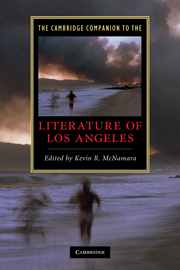Book contents
- Frontmatter
- Introduction: landmarks
- 1 The literature of the Californios
- 2 The Anglo invention of Los Angeles
- 3 LA fiction through mid-century
- 4 British expatriates and German exiles in 1930s-1940s Los Angeles
- 5 Postwar Los Angeles: suburban Eden and the fall into history
- 6 Los Angeles and the African-American literary imagination
- 7 Pacific Rim city: Asian-American and Latino literature
- 8 The literature of urban rebellion
- 9 City of sleuths
- 10 Los Angeles’ science fiction futures
- 11 Hollywood fictions
- 12 The Southland on screen
- 13 Scenes and movements in Southern California poetry
- 14 Surf, sagebrush, and cement rivers: Reimagining nature in Los Angeles
- 15 Essaying Los Angeles
- Guide to further reading
- Index
5 - Postwar Los Angeles: suburban Eden and the fall into history
Published online by Cambridge University Press: 28 May 2010
- Frontmatter
- Introduction: landmarks
- 1 The literature of the Californios
- 2 The Anglo invention of Los Angeles
- 3 LA fiction through mid-century
- 4 British expatriates and German exiles in 1930s-1940s Los Angeles
- 5 Postwar Los Angeles: suburban Eden and the fall into history
- 6 Los Angeles and the African-American literary imagination
- 7 Pacific Rim city: Asian-American and Latino literature
- 8 The literature of urban rebellion
- 9 City of sleuths
- 10 Los Angeles’ science fiction futures
- 11 Hollywood fictions
- 12 The Southland on screen
- 13 Scenes and movements in Southern California poetry
- 14 Surf, sagebrush, and cement rivers: Reimagining nature in Los Angeles
- 15 Essaying Los Angeles
- Guide to further reading
- Index
Summary
“I'd be safe and warm If I was in L.A.” The Mamas and the Papas, “California Dreamin'” (1965) / Driving over a hill into San Narciso, the LA suburb where she will begin her quest to execute the will of Pierce Inverarity, Oedipa Maas, the heroine of Thomas Pynchon's The Crying of Lot 49 (1966), views the scene spread out before her: “she looked down a slope. . .onto a vast sprawl of houses which had grown up all together, like a well tended crop, from the dull brown earth; and she thought of the time she'd opened a transistor radio to replace a battery and seen her first printed circuit. The ordered swirl of houses and streets, from this high angle, sprang at her now with the same unexpected, astonishing clarity as the circuit card had. Though she knew even less about radios than about Southern Californians, there were to both outward patterns a hieroglyphic sense of concealed meaning, of an intent to communicate.” / The “circuit” of the suburban sprawl that Oedipa observes is remarkably similar to the “grids” of D. J. Waldie's Holy Land: A Suburban Memoir (1996), the seemingly endless proliferation of tract home developments in Southern California laid out in mathematically precise matrices that contain “an indefinite number of beginnings and endings” and are built “outward without limits . . . the antithesis of a ghetto.” San Narciso's punning name is indicative of the voyeuristic narcissism to be found in the Southland's suburbs: mapped onto the real Southern California, Oedipa is conceivably coming over the Newhall Pass into the San Fernando Valley, home to Los Angeles' major television and movie studios and, since the 1970s, center of the US porn industry.
- Type
- Chapter
- Information
- The Cambridge Companion to the Literature of Los Angeles , pp. 59 - 74Publisher: Cambridge University PressPrint publication year: 2010
- 3
- Cited by

